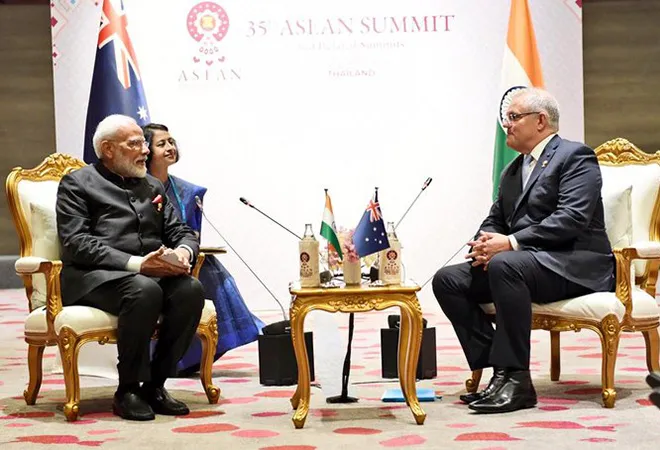
Indian Prime Minister Narendra Modi is set to host the first bilateral virtual summit with his Australian counterpart, Prime Minister Scott Morrison this week on 4 June to discuss a range of issues including joint fight against COVID-19 and Indo-Pacific partnership. The summit was initially planned to be held in January for which Prime Minister Morrison was expected to visit India, but the visit had to be cancelled for the bushfire crisis in Australia. Both sides have since been negotiating about the dates for conducting the summit. But with the ongoing pandemic, it got further stalled. India has been conducting virtual summits with SAARC and G20 members during this period which shows that it is using the diplomatic tool to strengthen its presence and voice both in its neighbourhood and in the global forums as well. Australia has supported these initiatives of PM Modi. The decision by Prime Minister Modi to conduct the very first virtual bilateral summit with the Australian Prime Minister is indicative of the upward trajectory that the relations between the two countries have been on in the current times. India and Australia are strategic partners — they engage in dialogues like Foreign Secretaries and Defence Secretaries 2+2 Dialogue, India-Australia-Indonesia Trilateral Dialogue, Japan-Australia-India Trilateral Dialogue. Last year, AUSINDEX, bilateral naval exercise between Australia and India was the most intense till date with the presence of four frontline ships with integral helicopters, one submarine and a variety of aircraft, including P8I and P8A long-range Maritime Reconnaissance Anti-Submarine Warfare aircraft.
India and Australia are strategic partners — they engage in dialogues like Foreign Secretaries and Defence Secretaries 2+2 Dialogue, India-Australia-Indonesia Trilateral Dialogue, Japan-Australia-India Trilateral Dialogue. Last year, AUSINDEX, bilateral naval exercise between Australia and India was the most intense till date.
The two sides plan to conclude a range of pacts including Mutual Logistics Sharing Agreement (MLSA) and in areas of science & technology and public administration on the occasion. The MLSA will make it easier for the militaries of both countries to conduct complex exercises and facilitate access to each other’s bases. Strengthening defence cooperation will be a major theme during the Modi-Morrison summit. According to the Australian High Commissioner to India, Barry O’Farrell the summit is also expected to advance an ambitious agenda that will include working together to “improve regional and multilateral institutions, including on COVID-19 and public health, boosting science and tech cooperation, stronger collaboration on cyber-security and critical technology, maritime issues in the Indo-Pacific, critical mineral supply chains, education, and water resource management.” Australia is presently concerned with reducing its economic dependence on the Chinese and in this context, Australia would want to export more goods to India, including agricultural products such as barley after China imposed an 80 per cent tariff on the grain. With 1.3 billion people and an emerging middle class, India represents a huge opportunity for Australian exporters. A new education partnership might also be on the cards as Australia seeks to diversify its international students so the sector is less dependent on China.
But strengthening cooperation in the Indo-Pacific, especially in the post-COVID world order, is expected to be one of the primary areas of discussion. High Commissioner Barry O’Farrell in a recent statement stressed the need for “like-minded democracies and important partners like Australia and India, to work together to shape the post-COVID multilateral order. India and Australia are committed to a free, open, inclusive and secure Indo-Pacific and strengthening and making their economies more resilient and both have a shared goal of strengthening international institutions as well.” In their last phone call in April, both the leaders agreed “to remain attentive to the wider significance of the India-Australia partnership, including in the Indo-Pacific region, while they focus on solving the present health crisis.”
Australia is presently concerned with reducing its economic dependence on the Chinese and in this context, Australia would want to export more goods to India.
The growing importance of the Indian and Pacific Oceans have given new momentum to the ‘Indo-Pacific’ as a geo-strategic construct. India and Australia are particularly prominent players. India flanks the Indian Ocean and Australia lies between the Indian and the South Pacific Oceans. In essence, India and Australia strategically anchor the Indo-Pacific in the northwest, and southeast. Both have articulated new or refreshed visions for their own engagement with the region, India through Prime Minister Narendra Modi’s vision for the Indo-Pacific, and Australia through the white papers that lay out its determination to ensure a “secure, open and prosperous Indo–Pacific.” If the Indo-Pacific view of the world is to prove meaningful, these two nations will need to find new ways to deepen their strategic conversation and their practical cooperation across a wide range of areas.
The summit comes against the backdrop of India and Australia having tense ties with China. In the case of India, tensions are due to the recent standoff at the Line of Actual Control (LAC). In the case of Australia, tensions are high due to the Australian government seeking an impartial probe into the spread of the COVID-19 pandemic and the origins of the disease. China has in recent weeks threatened economic consequences for Australia taking such a stance. Australia has also been lending support and alongside the US have been a part of the Freedom of Navigation exercises, joint patrols in the disputed South China Sea (SCS), where China has been flexing its muscles. Last year too Australia-China relations saw clashes over political interference, human rights abuses in western China and Huawei 5G equipment.
Australia has been lending support and alongside the US have been a part of the Freedom of Navigation exercises, joint patrols in the disputed South China Sea, where China has been flexing its muscles.
As prominent players in the Indo-Pacific desiring a free, open, rules based order and given the ongoing US-China tussle with regard to the origin and handling of the virus which has compelled smaller Southeast Asian countries to choose sides, India and Australia can build a ‘coalition of middle and rising powers.’ This can be done by engaging with the Southeast Asian countries like Vietnam, Indonesia, Malaysia who are at the receiving end of China’s aggressiveness in the South China Sea. Both India and Australia have strong ties with their Southeast Asian neighbours and in some way have been involved in the SCS issue, this only seems logical if they want to lead the way for the maintenance of a rules based order in the Indo-Pacific and making the Indo-Pacific regional architecture more inclusive. India’s Act East policy is aimed at establishing deeper economic engagement with Southeast Asia and broader cooperation with East Asia and the Pacific Island countries. PM Modi’s recently introduced ‘Indo-Pacific Oceans Initiative’ also seeks for the safety, security and stability of the maritime domain. Australia also seems to be looking to establish a multipolar Indo-Pacific order and ensuring that no single power dominates it.
Both the countries have been taking active steps towards shaping the multilateral order and the global response towards the pandemic. India by PM Modi’s efforts to engage with leaders and member countries of SAARC and G20 and now as the chairman of the WHO Executive Board, Australia through invoking the probe for investigating the origins of the virus. The two can bring in more like-minded countries besides Japan and the US in the Indo-Pacific region like Vietnam, Indonesia, South Korea, New Zealand and engage with them in a Quad Plus platform to help bring about change, more accountability in multilateral institutions specially the WHO. One of PM Modi’s key messages at the G20 summit was the need to strengthen the WHO. Countries like Vietnam, South Korea, New Zealand have been the few successful examples of dealing with COVID-19 so there needs to be platforms which can encourage experience-sharing in the context of this health crisis, including collaborative research efforts. India and Australia can take the responsibility of organising summits involving these other countries of the Indo-Pacific. A report can be drawn up based on the experiences of the participating countries and later presented at the platform of the WHO as a united response of the Indo-Pacific countries in dealing with COVID-19.
Both India and Australia have strong ties with their Southeast Asian neighbours and in some way have been involved in the South China Sea issue.
The long-term strategic stability of Indo-Pacific thus depends to a significant degree on the two countries and how they interact with one another. Given the regional uncertainty in the Indo-Pacific, and the limitations of existing multilateral institutions and bilateral partnerships, stronger cooperation and alignment between the two countries could boost regional stability and provide strategic benefits for both.
The views expressed above belong to the author(s). ORF research and analyses now available on Telegram! Click here to access our curated content — blogs, longforms and interviews.




 PREV
PREV


